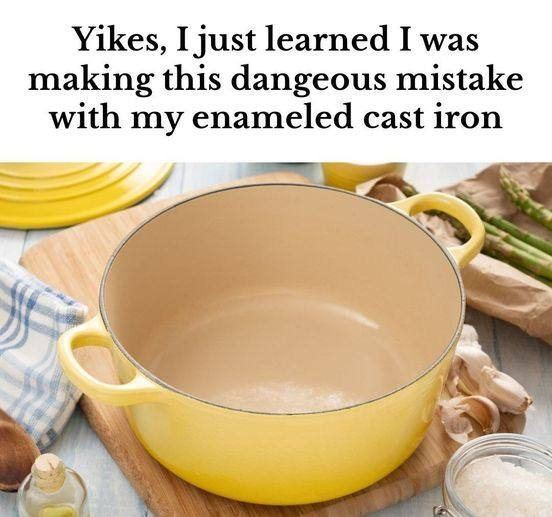ADVERTISEMENT
- Use Medium to Low Heat
Enameled cast iron is best used on medium to low heat. This allows the cookware to heat evenly and prevents the enamel from being exposed to sudden temperature changes. Steady, moderate heat is ideal for searing, simmering, or braising your food. - Preheat Gradually
Instead of cranking up the heat right away, give your enameled cast iron time to warm up gradually. Preheating over a low flame or heat setting ensures the enamel doesn’t crack from a sudden shock of heat. It’s a little patience that pays off in the long run! - Avoid Empty Preheating
Never preheat your enameled cast iron pan on high heat without food in it. Dry heating can cause the enamel to crack, especially when using cast iron on stovetops or in ovens. Always ensure there’s oil or food in the pan before heating it up to avoid unnecessary stress on the enamel. - Use Heat Diffusers or Silicone Trivets
If you’re cooking at high heat on a gas burner, consider using a heat diffuser to evenly distribute the heat. This can help prevent hot spots that might cause the enamel to crack. Additionally, silicone trivets or pot holders can protect your cookware from direct heat when transferring it between burners or the oven. - Oven Temperature Considerations
When using your enameled cast iron in the oven, avoid temperatures higher than 500°F (260°C). While some enameled cast iron cookware is rated for higher temperatures, it’s generally best to avoid the extreme heat to preserve the enamel and cast iron beneath. - Cleaning and Cooling
Always allow your enameled cast iron cookware to cool before cleaning it. Rapid cooling by running cold water over a hot pan can cause the enamel to crack. Let it come down to room temperature first, and then clean it with warm, soapy water and a gentle scrub brush.
What to Do if You’ve Already Made the Mistake
If you’ve already made the mistake of using high heat on your enameled cast iron cookware, don’t panic. There are ways to assess the damage and potentially fix minor issues:
- Inspect for Cracks or Chips: Carefully examine your cookware for any visible cracks or chips in the enamel. If the damage is minor, it might not affect the cooking performance, but it’s best to avoid using the cookware at high heat again.
- Restore Color: If the cookware has become discolored, try cleaning it with a paste made of baking soda and water to restore its appearance. This won’t fix any structural damage but can help with cosmetic issues.
- Use Caution Moving Forward: Going forward, ensure you follow the tips above for safe use to prevent any further damage and keep your enameled cast iron in excellent condition.
Conclusion
Enameled cast iron cookware is a valuable kitchen investment, and it’s important to take care of it properly to ensure it lasts for years. The most common mistake people make with enameled cast iron is exposing it to high heat, which can cause enamel cracking, discoloration, and even warping. By using moderate heat, preheating gradually, and cleaning carefully, you can avoid these issues and continue to enjoy the excellent cooking performance of your enameled cast iron for many meals to come.
Remember: a little care and patience with your cookware will go a long way in preserving its beauty and functionality. So, next time you reach for that enameled cast iron pot, remember to keep the heat at a moderate level and cook with confidence!
I hope this article helps bring attention to a common mistake and gives your readers the right tips for taking care of their enameled cast iron cookware! Let me know if you want any changes or additions.
ADVERTISEMENT
ADVERTISEMENT
